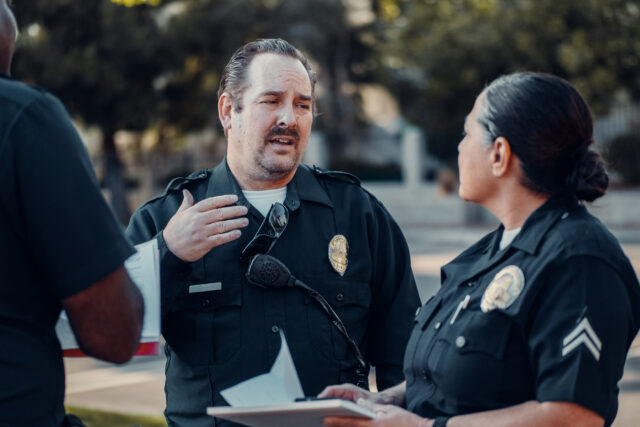As California, and the nation, have experienced troubling increases in homicides and aggravated assaults, the state’s residents’ confidence in police in their community doing an excellent or good job in controlling crime has declined notably. These worrisome trends may partly be related to decreases in police staffing, as research has found that these decreases are linked to increases in crime, especially violent crime. The state saw a sizeable drop in staffing across all law enforcement agencies between 2020 and 2021—and this decline is part of much longer-term trends.
Recent research finds that increased police staffing helps to prevent crime, primarily through deterrence, in medium and large cities. This effect is particularly strong for violent crime, especially homicides; an increase in police staffing by 10% is estimated to reduce violent crimes broadly by 3.4% and homicides by 6.7%. Property crime, broadly speaking, reduces by 1.7%. Additionally, this research also shows that the crime-reducing benefits of hiring an additional police officer exceed the annual cost.
The effects on different racial/ethnic communities are mixed. For example, research finds that increased staffing results in a greater reduction in homicides of Black victims than white victims. But it also finds increases in arrests for lower-level offenses like liquor violations and disorderly conduct—and these arrests fall disproportionately on Black residents.
Here we use California Department of Justice’s Law Enforcement Personnel Survey to examine changes in law enforcement staffing. As of 2021, there were over 117,000 full-time law enforcement employees in California; of these, 77,600 were sworn law enforcement officers with full arrest powers. This group includes about 10,900 officers assigned to jails and 66,700 officers that work outside jails. A majority of these officers are out patrolling our highways and neighborhoods, but this category also includes police chiefs, supervisors, and detectives.
In total, the state lost 2,100 sworn law enforcement officers in 2021; almost 1,400 were patrol officers. While these numbers as percentages are arguably small (around 2.6% and 2% respectively), they are part of a longer term decline.
The figure below shows the number of total sworn law enforcement officers and patrol officers over time, measured as a rate per 100,000 residents to account for changes in the state’s population. The variation over time shows that these numbers are sensitive to economic swings, such as the recession of the early 1990s and the Great Recession of 2008–2009. More recently, in 2021 the rate dropped to 197 sworn officers per 100,000 residents, the lowest reported since 1995.
Focusing on the number of patrol officers, who are arguably linked most closely to crime prevention, we see a similar trend, except the decrease since 2008 is greater. The number of patrol officers per 100,000 residents has dropped from 195 in 2008 to 169 in 2021, a decrease of 13.2%, and is now the lowest since at least 1991 (the furthest back our data goes).

Decreases in patrol officers varies by agency. All of the state’s 10 largest police departments saw decreases in the number of patrol officers from a statewide peak in 2008. San Jose and Oakland police departments experienced the biggest drops (by 22% and 20% respectively), while Bakersfield and Los Angeles saw the smallest (by 15% and 5% respectively).

Shifting the focus to county level changes, which adds sheriff departments and all other law enforcement agencies, we see that all but one of the 10 largest counties saw double digit percentage decreases. Riverside, Santa Clara, and Sacramento all saw decreases of more than 20%, while in San Bernardino it dropped by 8%.

Among the 16 middle-sized counties, those with less than 1 million residents but more than 250,000, four experienced drops between 20% and 25% (Ventura, San Mateo, Stanislaus, and Monterey). Two saw decreases of less than 10% (Tulare and Santa Cruz), while one (San Luis Obispo) saw an increase of 2%.
In the 32 smallest counties, those with less than 250,000 residents, the changes vary notably, partly reflecting sensitivities to changes in small numbers of officers. In Glenn County (with a population of 29,000), the patrol officer rate dropped by 44%. In five counties it dropped by between 20% and 30% (Del Norte, Imperial, Mono, Siskiyou, and Tehama). Ten small counties saw increases, and of these, four saw increases of at least 10% (Trinity, Madera, Kings, and Lassen).

California’s law enforcement agencies lost close to 1,400 patrol officers in 2021, roughly 26% of the overall decrease of 5,300 officers between 2008 and 2021. The connection to recent increases in some violent crime are still unclear, but research suggests that decreases in police staffing may have contributed to some extent.
Addressing staffing deficits requires increases in hiring and in the retention of experienced officers. Perhaps more importantly, it also necessitates efforts to ensure that new hires and existing staff are well trained and ready to improve confidence and trust in law enforcement.







